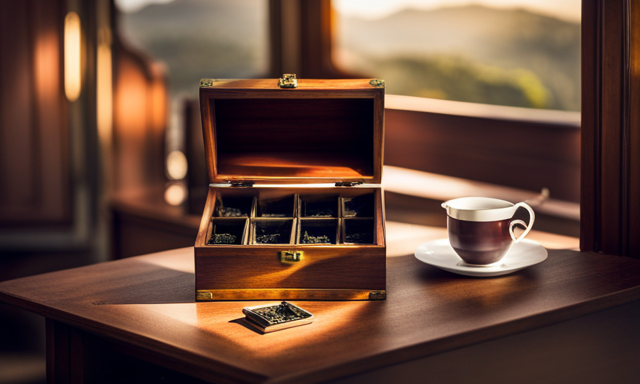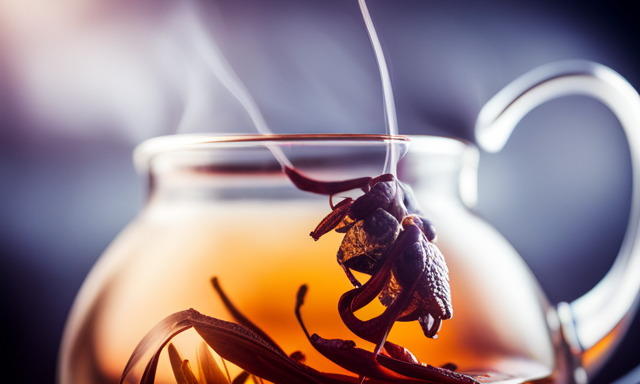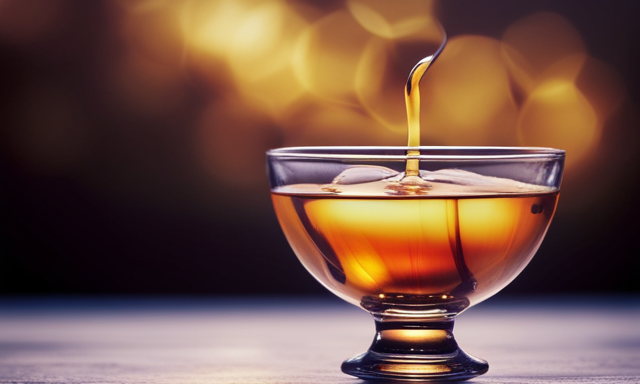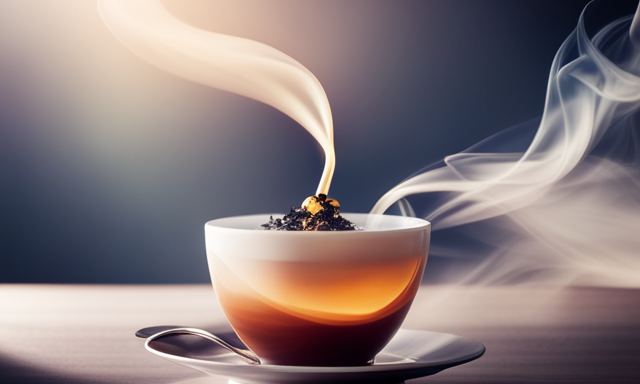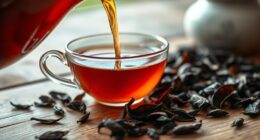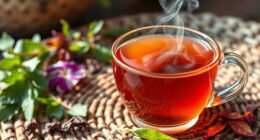As a tea lover, I understand the importance of storing oolong tea properly to maintain its freshness and flavor. It’s like preserving a precious treasure, ensuring that each sip is a delightful experience.
In this article, I will share with you my knowledge and expertise on how to store oolong tea correctly, so that you can enjoy its rich and complex taste for as long as possible.
We will explore the shelf life of oolong tea and learn how to choose the right storage container. I will guide you through the process of finding the perfect cool and dry place for your tea, away from strong odors that can affect its delicate aroma.
We will also discuss the importance of avoiding exposure to light and heat, and how to use proper tea storage accessories.
So, let’s embark on this journey together and discover the secrets of storing oolong tea like a true connoisseur.
Key Takeaways
- Properly sealing oolong tea is essential for preserving its taste and aroma by removing excess air and moisture.
- Using proper tea storage techniques helps maintain the freshness of oolong tea and prolong its shelf life.
- Regularly checking and rotating the tea stock ensures that oolong tea is consumed when it is fresh and at its best quality.
- It is important to be vigilant for signs of tea going bad, such as moisture, mold, or strong odors, to avoid consuming spoiled oolong tea.
Understand the Shelf Life of Oolong Tea
You’ll be amazed at how long your oolong tea can stay fresh when stored properly. As an expert in oolong tea brewing techniques, I can assure you that understanding the shelf life of oolong tea is essential.
Oolong tea, with its unique processing method, can maintain its freshness for up to two years if stored correctly. This exquisite tea not only boasts a delightful taste but also offers numerous health benefits. It’s known to aid in weight management, boost metabolism, and reduce the risk of heart disease.
So, to preserve the quality of your oolong tea, it’s crucial to choose the right storage container.
Now, let’s move on to the next section and explore how to select the perfect storage container for your oolong tea.
Choose the Right Storage Container
To ensure your oolong tea stays fresh and flavorful, opt for a suitable storage container that preserves its delicate aroma and taste. Choosing the right storage container for oolong tea is crucial in maintaining its freshness.
Look for a container that is airtight and opaque, as exposure to air, light, and moisture can degrade the quality of the tea leaves. Glass jars with tight-fitting lids or metal tins with inner seals are ideal options. Avoid using plastic containers as they can retain odors and affect the taste of the tea.
Additionally, consider the size of the container based on the amount of tea you plan to store. By selecting a proper storage container, you can prolong the shelf life of your oolong tea and enjoy its rich flavors for months to come.
When it comes to storing oolong tea, it’s important to also keep it in a cool and dry place.
Store Oolong Tea in a Cool and Dry Place
For optimal taste and freshness, make sure to keep your oolong tea in a cool and dry place. Proper storage is crucial for preserving the quality and flavor of oolong tea. Improper storage can significantly affect the taste and aroma of the tea, leading to a disappointing experience.
To evoke emotion and emphasize the importance of proper storage, consider the following:
- Protect the delicate flavors by avoiding exposure to heat and sunlight.
- Prevent moisture from seeping in, which can make the tea leaves damp and cause them to lose their flavor.
- Store oolong tea away from strong odors, as it can absorb unwanted smells and alter the taste.
- Use airtight containers to maintain freshness and prevent the tea from absorbing odors from its surroundings.
By understanding the importance of proper oolong tea storage, you can ensure that your tea remains flavorful and enjoyable.
Now, let’s move on to the next section about keeping oolong tea away from strong odors.
Keep Oolong Tea Away from Strong Odors
Immerse yourself in a fragrant oasis by safeguarding your precious oolong brew from the clutches of overpowering scents. To preserve the delicate aroma of your tea, it is crucial to keep it away from strong odors. Oolong tea is highly susceptible to absorbing surrounding smells, which can greatly impact its taste and quality. By storing your oolong tea in airtight containers, you can prevent tea oxidation and maintain its freshness. To evoke the importance of this step, imagine a serene table setting with three columns and three rows: one column filled with vibrant oolong leaves, another with aromatic spices, and the last one with pungent onions. The contrast is striking, emphasizing the need to protect your tea from overpowering odors. Now, let’s delve into the next section about avoiding exposure to light and heat, to further safeguard your oolong tea.
Avoid Exposure to Light and Heat
Safeguarding your precious oolong brew means protecting it from the relentless grip of light and heat, which can diminish its essence and leave it lacking in flavor and vitality. To ensure your oolong tea stays fresh and flavorful, it’s crucial to avoid exposure to moisture and store it in airtight containers.
Moisture can cause the tea leaves to absorb unwanted odors and flavors, compromising the quality of your brew. Airtight containers create a barrier against moisture, as well as light and heat, preserving the delicate flavors and aromas of oolong tea. By storing your oolong tea in proper containers, you can prolong its shelf life and maintain its optimal taste.
Moving on to the next section about "use proper tea storage accessories," let’s explore additional ways to keep your oolong tea in its prime condition.
Use Proper Tea Storage Accessories
When it comes to storing oolong tea, using the right accessories is essential. Tea tins or ceramic jars are perfect for preserving the flavor and freshness of the tea leaves. These containers provide airtight seals, keeping moisture and light out, ensuring the tea remains in optimal condition.
Additionally, vacuum sealing is another option to consider, as it removes all the air from the storage container, further protecting the tea from oxidation and degradation.
Use Tea Tins or Ceramic Jars
To properly store oolong tea, it’s best to use tea tins or ceramic jars. These containers provide airtight and light-proof conditions, ensuring the tea’s freshness and flavor are preserved. Here are four reasons why tea tins or ceramic jars are ideal for storing oolong tea:
-
Tea canisters: Tea tins are specifically designed for storing tea, with airtight lids that keep out moisture and air. They come in various sizes and designs, allowing you to choose one that suits your style.
-
Ceramic jars: Ceramic jars offer excellent insulation, protecting the tea from heat and light. They also add a touch of elegance to your kitchen or tea cabinet.
-
Glass containers: Glass containers are another option, allowing you to see the tea leaves and monitor their condition. However, ensure they have airtight lids to maintain the tea’s freshness.
-
Preserving aroma and flavor: Tea tins or ceramic jars prevent the tea from absorbing odors or flavors from other items, preserving the unique aroma and taste of oolong tea.
Consider using vacuum sealing to further extend the shelf life of your oolong tea without compromising its quality.
Consider Using Vacuum Sealing
Consider using vacuum sealing to prolong the lifespan of your oolong tea while preserving its impeccable quality. Vacuum sealing offers numerous benefits when it comes to storing tea.
By removing the air from the storage container, it helps to prevent oxidation and maintain the freshness of the tea leaves. This method also prevents moisture and other contaminants from affecting the flavor and aroma of your oolong tea.
While tea tins or ceramic jars are popular choices, vacuum sealing provides an additional layer of protection. It’s a great alternative storage method, especially if you want to keep your tea fresh for a longer period.
However, it’s important to note that freezing oolong tea is not recommended as it can alter the taste and texture. Instead, let’s explore other effective ways to preserve your precious oolong tea.
Don’t Freeze Oolong Tea
Avoid freezing oolong tea as it can negatively impact the delicate flavor and aromas that make it so enjoyable. Instead, consider using freezing alternatives to prolong its freshness. Vacuum sealing is a great option as it helps to preserve the tea’s taste and aroma by removing excess air and moisture. This method ensures that the tea leaves remain in optimal condition for a longer period of time.
When it comes to brewing oolong tea, it’s important to use the best brewing methods to fully appreciate its unique characteristics. Whether you prefer steeping it in a teapot, using a gaiwan, or employing the traditional Gongfu style, each brewing method brings out different aspects of the tea’s flavor profile.
To maintain a fresh supply of oolong tea, it’s essential to check and rotate your tea stock regularly. This ensures that you’re always consuming the freshest tea possible and avoids the risk of the tea losing its flavor over time.
Check and Rotate Your Tea Stock Regularly
Regularly checking and rotating your stock of tea ensures the freshness and quality of your brews. One way to do this is by checking the tea quality. Look for any signs of moisture, mold, or strong odors, as these indicate that the tea may have gone bad. Another important aspect is proper tea storage techniques. To help you keep track of your tea stock, use the table below:
| Type of Tea | Quantity | Date Purchased | Expiration Date |
|---|---|---|---|
| Oolong | 3 packs | 05/2021 | 05/2023 |
| Green | 2 packs | 06/2021 | 06/2023 |
| Black | 1 pack | 07/2021 | 07/2023 |
| Herbal | 4 packs | 08/2021 | 08/2023 |
By regularly checking and rotating your tea stock, you can ensure that you always have fresh and high-quality tea for brewing. Now, let’s move on to the next section and learn how to enjoy your freshly stored oolong tea.
Enjoy Your Freshly Stored Oolong Tea
Indulge in the rich flavors and aromatic notes of your recently stored batch of oolong tea, savoring each sip and embracing the moments of pure relaxation.
Not only does oolong tea offer a delightful taste experience, but it also provides numerous health benefits. Regular consumption of oolong tea has been linked to improved heart health, weight management, and a strengthened immune system.
To make the most of your freshly stored oolong tea, it’s important to explore different brewing methods. Whether you prefer a traditional gongfu style or a convenient teapot, each method brings out unique flavors and characteristics in the tea leaves. Experiment with steeping times and water temperatures to find the perfect balance for your taste buds.
So sit back, unwind, and enjoy the many benefits that oolong tea has to offer.
Frequently Asked Questions
Can I store my oolong tea in the refrigerator?
Sure, you can store your oolong tea in the refrigerator. However, it’s best to use airtight containers to maintain freshness. Keep the temperature between 35-45°F for optimal storage.
How long can oolong tea be stored before it goes bad?
Oolong tea can be stored for up to 2 years before it goes bad if stored properly. To maximize shelf life, store it in an airtight container away from light, heat, and moisture.
Can I store oolong tea in a plastic container?
Yes, you can store oolong tea in a plastic container, but it’s not the best choice. To keep its flavor intact, use an airtight container made of ceramic or glass.
Is it necessary to check the expiration date on oolong tea before storing it?
It is important to check the expiration date on oolong tea before storing it, as it ensures freshness and quality. Optimal storage conditions include keeping it in a cool, dark place away from moisture and strong odors.
Can I store oolong tea in a glass jar instead of a tin container?
Yes, oolong tea can be stored in a glass jar as an alternative to a tin container. Glass jars provide airtight storage, protecting the tea from moisture and light, ensuring its freshness and flavor.
Conclusion
In conclusion, properly storing oolong tea is crucial to maintaining its freshness and flavor. By understanding the shelf life and following the right storage methods, such as using airtight containers and keeping it in a cool, dry place, you can ensure that your oolong tea remains at its best.
Remember to check and rotate your tea stock regularly to prevent any spoilage. Just imagine, with these storage techniques, your oolong tea will be as invigorating as a vibrant bouquet of blooming flowers. Happy tea drinking!

